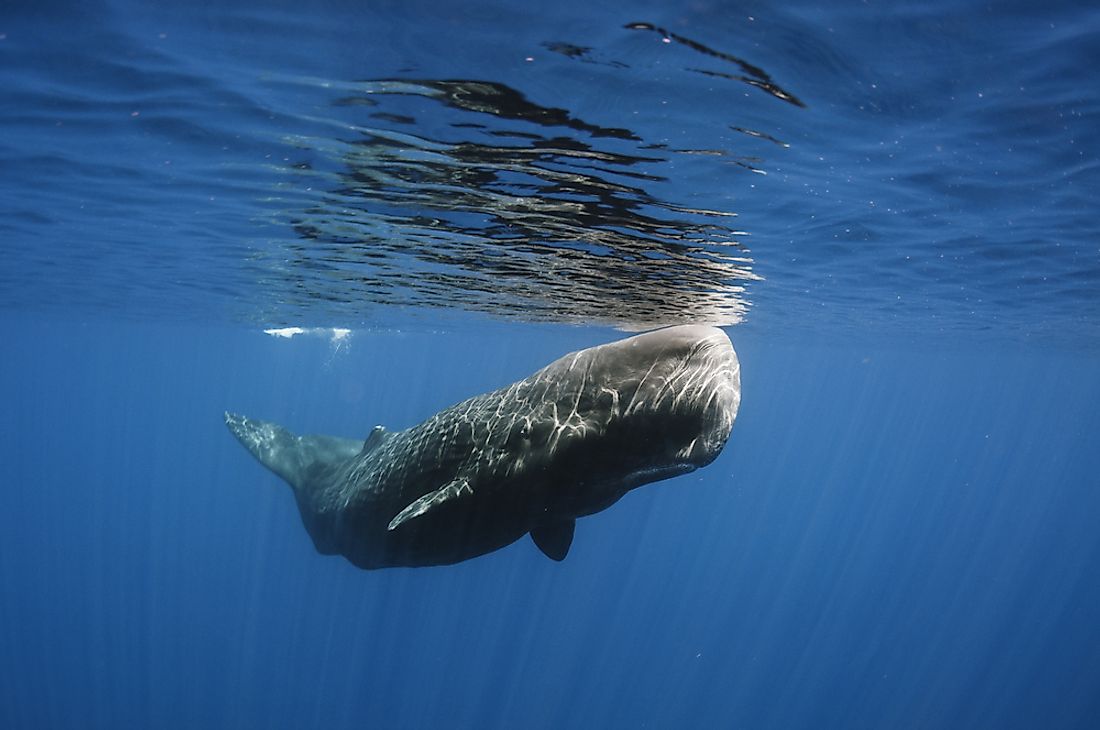Endangered Whales

Whales are an integral part of the marine ecosystems of the world, playing an important role in the marine food chain. These whales check the overgrowth of marine populations of krill and other creatures in the ocean which would otherwise hamper the growth of other species sharing the marine habitat. Some of the world's endangered whale species include the sei, blue, and North Atlantic Right whales, while vulnerable whale species are the sperm whale and the fin whale.
5. Sperm whale
Sperm whales, possessing the largest brains of all animals on Earth, also have large volumes of a substance known as spermaceti in their heads which gives them their name. Scientists believe this substance could aid in the movement of whales by altering their buoyancy. The sperm whales consume nearly a ton of fish and squids a day and often dive as much as 3,280 feet below the ocean in search of prey. They are also highly sociable animals and live together in large groups of 15 to 20 animals where females often exhibit communal nursing. The sperm whales have also not been spared by the exploitative action of man and today, they are classified as vulnerable by the IUCN. The sperm whales have a wide range of distribution including both tropical and temperate seas and oceans. They are primarily hunted for their oil and ambergis (a stomach waste product from the whale), the latter a substance used in perfumery.
4. Sei whale
The sei whales are gigantic creatures found in the subarctic and subtropical deep waters of the world’s oceans. These whales consume around 900 kilograms of food each day and grow up to a length of 64 feet and weight as much as 28 metric tons. Krill, fishes, and zooplankton form a major part of their diets. These whales are also excellent swimmers and can move at speeds as high as 50 kilometers per hour. During the late 18th Century and throughout the 20th Century, the sei whales were extensively hunted. Today, only 80,000 of these animals remain, forcing the IUCN to classify the sei whales as endangered. The whales are now protected throughout the world with the exception of Japan where some commercial whaling of this species is still carried out.
3. Fin Whale
The fin whales are only second in size to the blue whales, the largest mammals on Earth. The fin whales posses a long, slender body, perfectly streamlined to swim at speeds faster than that of many man-made steamships. The whales grow up to about 89.6 feet and can weigh as much as 74 metric tons. They feed on fishes, krill, copepods, and crustaceans. The fin whales are widespread in distribution, occupying the world’s oceans between the poles and the equator. However, despite their wide choice of habitat, only around 100,000 fin whales survive today, necessitating the need to classify them as endangered. Extensive hunting episodes in the last two centuries has led to the threatened status of these animals. Though an international moratorium on fin whale hunting has been established, Japan and Iceland still continue to hunt these whales.
2. Blue Whale
Sadly, the blue whales, the world's largest living animals, are significantly reduced in numbers with only 10,000 to 25,000 individuals surviving today. Blue whales are really massive, growing as long as 100 feet and weighing as much as 200 tons. It is estimated that a blue whale’s tongue itself is the weight of an elephant! Quite surprisingly, these gigantic creatures feed primarily on tiny creatures called krill, consuming up to 4 metric tons of krill daily. The blue whales live in pairs or alone and are very vocal in nature. The blue whales have a wide distribution, found in the world’s oceans from the poles to the equator, exhibiting seasonal migrations from the polar and subarctic regions in summer to the tropical and subtropical waters in winter. The blue whales are currently classified as endangered by the IUCN. Hunting by humans is the major reason of decline of these species. The whales have also been subjected to death upon impact with large ships.
1. North Atlantic Right Whale
With only a few hundred surviving individuals, the North Atlantic Right Whale is the most threatened whale species in the world today, being classified as critically endangered by the IUCN. These whales are found in two distinct populations, in the western North Atlantic and the eastern North Atlantic. These whales weigh around 40,000 to 70,000 kilograms and grow in length to about 52 feet. Their rapid decline in population is a result of accidental deaths upon impacts with ships, entanglement in fishing gear, climate change and previous episodes of mass-scale poaching for oil.
Endangered and Vulnerable Whale Species
| Rank | Whale Species | Status |
|---|---|---|
| 1 | Sei | Endangered |
| 2 | Blue | Endangered |
| 3 | North Atlantic Right | Endangered |
| 4 | North Pacific Right | Endangered |
| 5 | Sperm | Vulnerable |
| 6 | Fin | Vulnerable |











